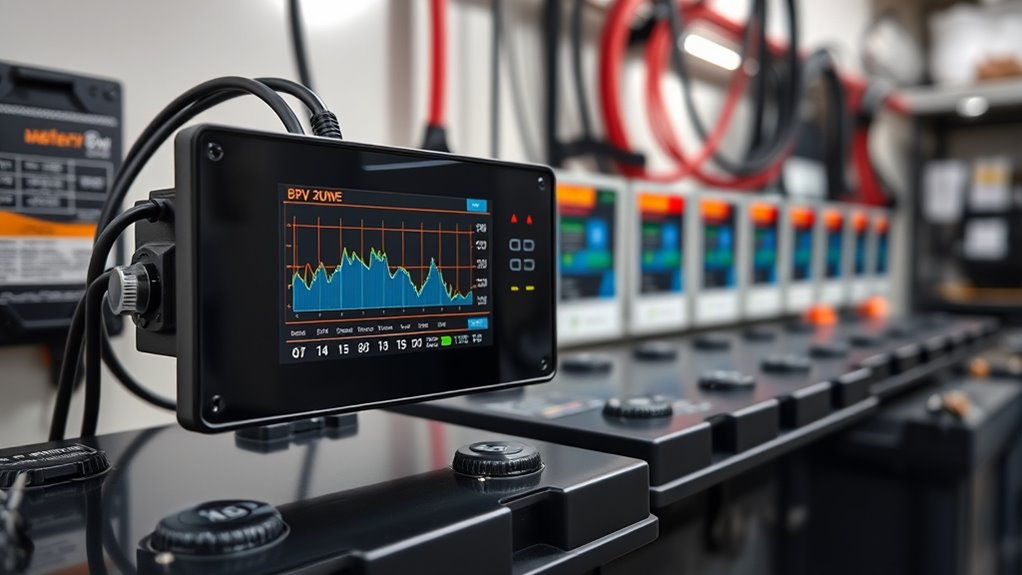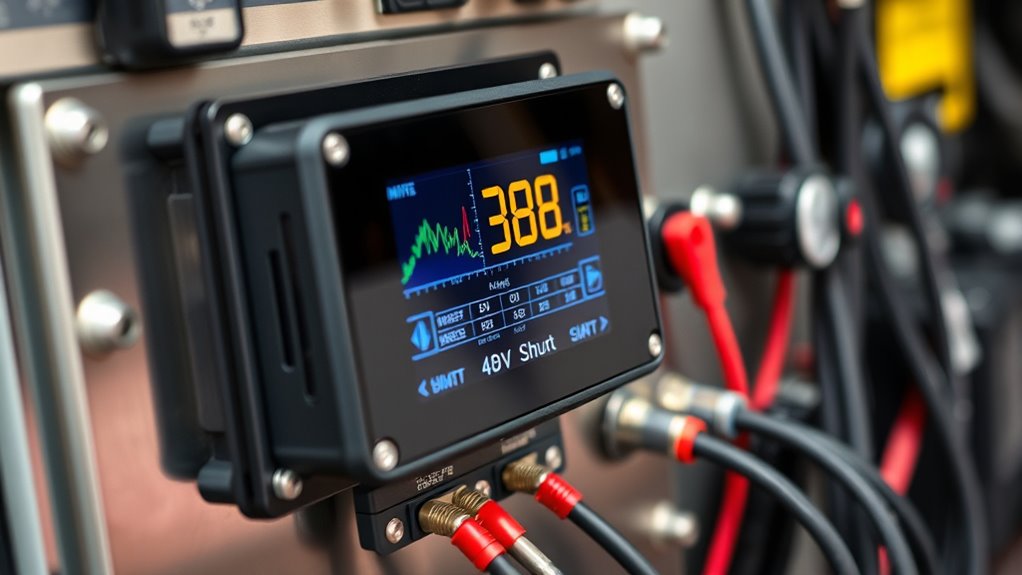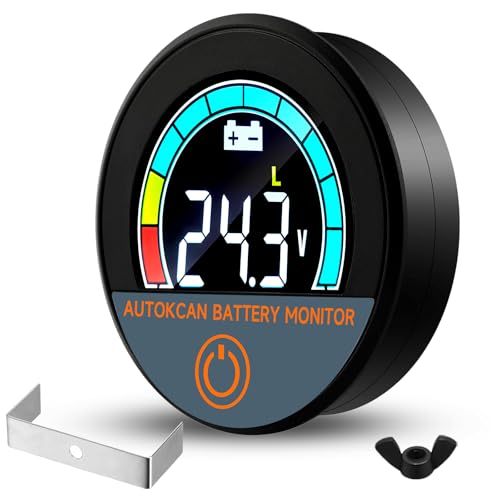When searching for the best battery monitors with shunt for 48V systems, I focus on models offering high accuracy, durable displays, and easy installation. Top options include Bluetooth-enabled monitors like the Victron SmartShunt and ANCEL BM1000, which provide real-time data on voltage, current, and capacity. Many support multiple battery chemistries and feature alarms for safety. Keep in mind your system’s size and needs, and if you continue, you’ll discover detailed insights to help you choose the perfect monitor.
Key Takeaways
- Prioritize monitors supporting 48V systems with high current capacity (≥500A) and wide voltage compatibility for versatile applications.
- Choose models with full-color LCD displays, clear visuals, and customizable backlighting for easy real-time data monitoring.
- Ensure compatibility with various battery chemistries like lithium, lead acid, and gel for system flexibility.
- Opt for monitors with high measurement accuracy (±1% or better) and reliable, factory-calibrated shunts.
- Consider features like Bluetooth connectivity, alarms, and data logging for comprehensive, remote battery health management.
ANCEL BM1000 Bluetooth Battery Monitor with Shunt
The ANCEL BM1000 Bluetooth Battery Monitor with Shunt is an excellent choice for anyone managing 48V systems, such as RVs, solar setups, or marine applications. It supports 10–120V DC systems, making it highly versatile. Designed to handle up to 400A with a dedicated shunt, it provides reliable, precise real-time data on voltage, current, amp-hours, and state of charge. Bluetooth connectivity allows easy monitoring via smartphone apps, offering clear graphs and logs. Installation is straightforward, with dedicated terminals and minimal power draw. Overall, it’s a dependable tool that helps optimize battery health and system performance across various mobile and off-grid applications.
Best For: DIY enthusiasts, RV owners, marine and solar system users seeking accurate, real-time battery monitoring for 10–120V DC systems up to 400A.
Pros:
- Highly accurate ±1% readings with factory calibration and stable Bluetooth connectivity.
- Supports a wide voltage range (10–120V DC), suitable for various applications like RVs, solar, and marine systems.
- User-friendly app with intuitive interface, detailed graphs, and customizable alarms for comprehensive monitoring.
Cons:
- Limited documentation and potential challenges in mounting or wiring due to shunt cable length.
- Occasional connectivity issues with the Bluetooth app, affecting remote monitoring.
- Short shunt cables may require additional extension for larger or more complex setups.
Victron Energy SmartShunt Battery Monitor (Bluetooth)
If you’re looking for a highly accurate, easy-to-use battery monitor for 48V systems, the Victron Energy SmartShunt Bluetooth stands out as an excellent choice. It provides detailed insights into voltage, current, state of charge, charge cycles, and discharge history via a user-friendly smartphone app. Designed for simple installation, it supports monitoring multiple batteries and integrates seamlessly with Victron’s ecosystem through VE.Smart Networking. While Bluetooth range can be limited, pairing it with a CerboGX or Wi-Fi connection improves stability and remote access. Overall, it’s a reliable, versatile device ideal for off-grid, RV, marine, and solar setups.
Best For: off-grid, RV, marine, and solar enthusiasts seeking precise, easy-to-use battery monitoring for 48V systems with seamless ecosystem integration.
Pros:
- High-accuracy monitoring of voltage, current, SOC, and discharge history via smartphone app
- Easy retrofitting and installation with versatile auxiliary connections
- Seamless integration with Victron ecosystem through VE.Smart Networking for remote management
Cons:
- Limited Bluetooth range and occasional disconnection issues requiring power cycling
- Lack of a public API for custom third-party integrations
- Minor installation inconveniences such as missing screws or mismatched post sizes
Renogy Battery Shunt 300 with Remote Monitoring
Looking for a reliable battery monitor that offers precise real-time data and remote access? The Renogy Battery Shunt 300 fits the bill perfectly. It supports various battery types, including lead acid, lithium, and Ni-MH, making it versatile for different setups. With Bluetooth connectivity, you can monitor your battery’s performance remotely via the DC Home app or Renogy ONE. It measures current up to 500A and provides detailed historical data and alerts for abnormal conditions. Plus, it includes temperature sensors to help maintain battery health and prevent overheating. Overall, it’s a solid choice for anyone needing accurate, remote monitoring for their 48V system.
Best For: those seeking a versatile, precise, and remotely accessible battery monitoring solution for various battery chemistries and system configurations.
Pros:
- Supports multiple battery types including lead acid, lithium, and Ni-MH for broad compatibility
- Bluetooth connectivity enables remote monitoring via the DC Home app or Renogy ONE
- Includes temperature sensors to help optimize battery health and prevent overheating
Cons:
- Not compatible with Renogy ONE M1
- Requires smartphone or Bluetooth-enabled device for remote access
- Limited to 500A current measurement, which may be insufficient for very large systems
Battery Monitor Voltage Meter for 12V-84V Systems
A waterproof digital voltage meter designed for 12V to 84V systems offers an excellent solution for those needing reliable battery monitoring across various applications. It features a round LCD display that’s easy to read and switchable between voltage, temperature, or battery percentage. Compatible with multiple battery types, including lead-acid and lithium, it suits golf carts, boats, motorcycles, and more. Installation is straightforward with a screw-in design and versatile mounting options. The device is IP67 waterproof, ensuring durability outdoors. With accurate readings within ±0.2V and simple calibration, it provides essential real-time data to prevent unexpected power loss and optimize battery performance.
Best For: DIY enthusiasts, outdoor adventurers, and anyone needing reliable battery monitoring for 12V-84V systems in applications like golf carts, boats, and lawnmowers.
Pros:
- Easy screw-in installation with versatile mounting options.
- Bright, daylight-readable LCD display with adjustable duration.
- Accurate voltage readings within ±0.2V and compatible with multiple battery types.
Cons:
- May have reduced visibility or readability in direct sunlight or at certain angles.
- Some users report occasional inaccurate readings or device malfunctions.
- Instruction manual and calibration process can be improved for clarity.
Renogy 500A Battery Monitor with Shunt
The Renogy 500A Battery Monitor with Shunt stands out as an ideal choice for those managing large 48V battery systems, thanks to its high current capacity and precise measurement capabilities. It offers 1% accuracy in real-time voltage and current readings, supporting various battery types like Lead Acid, Lithium Iron Phosphate, and Nickel-metal. The high-definition backlit display clearly shows voltage, current, power, capacity, and degradation. With a long 20ft cable and easy plug-and-play installation, it simplifies setup. Its alarms prevent over-discharge, and the device operates efficiently across a wide temperature range, making it a reliable tool for serious energy management.
Best For: individuals managing large 48V battery systems who need accurate, real-time monitoring of voltage, current, and battery health.
Pros:
- High 1% measurement accuracy for voltage and current readings.
- Supports multiple battery types including Lead Acid, Lithium Iron Phosphate, and Nickel-metal.
- Easy installation with a long 20ft cable and plug-and-play setup, plus clear high-definition display.
Cons:
- Limited to systems within 10V-120V, which may not suit very high-voltage setups.
- Requires a lithium-ion battery for power, which could be a consideration for some users.
- As a specialized device, it may be overkill for small or simple battery systems.
500A Shunt Battery Monitor with 2.4″ Color Screen and 16ft Shielded Wire
If you need a reliable way to monitor your 48V battery system accurately, the LNEX 500A Shunt Battery Monitor is an excellent choice, especially with its bright 2.4-inch full-color LCD screen. It provides clear real-time data on voltage, current (up to 500A), capacity, power, and state of charge. The adjustable brightness, backlighting, and pulsing during charging enhance visibility in various lighting conditions. The included 16-foot shielded wire allows flexible placement, reducing interference. Its user-friendly interface, combined with high-precision measurements and automatic data storage, makes it a practical and dependable tool for managing your battery system efficiently.
Best For: RV owners, solar energy enthusiasts, and electric vehicle users seeking accurate, real-time battery monitoring for 48V systems.
Pros:
- Bright 2.4-inch full-color LCD screen with adjustable brightness and backlighting for clear visibility in all lighting conditions
- High-precision 500A shunt and advanced detectors ensure accurate voltage and current readings
- Easy installation with a 16ft shielded wire for flexible placement and minimal interference
Cons:
- Proper calibration is required for optimal accuracy, which may be complex for some users
- Limited to systems within 8V–100V, so incompatible with higher voltage setups
- The need for manual calibration and system setup may require technical knowledge for first-time users
BINTA Battery Monitor with Shunt 8-120V 0-500A
For anyone managing large battery banks in RVs, boats, or solar setups, the BINTA Battery Monitor with Shunt 8-120V 0-500A stands out as an essential tool. It provides real-time data on charge level, remaining capacity, voltage, and current, supporting a variety of battery types like lead-acid, LiFePO4, and lithium-ion. With peak support up to 500A, it’s suitable for high-current systems. Its sleek design, backlit display, and easy installation make it user-friendly. Users find it accurate and reliable, especially with features like auto-sleep and data retention. Proper wiring is critical, but overall, it’s a versatile, high-quality monitor to optimize your battery management.
Best For: RV, boat, solar energy system owners, and anyone managing large or high-current battery banks seeking accurate real-time battery monitoring.
Pros:
- Supports a wide voltage range (8-120V) and high peak current (up to 500A), suitable for various applications.
- Features a backlit display with touch buttons for easy readability and operation in different lighting conditions.
- Provides comprehensive real-time data on charge level, remaining capacity, voltage, and current, aiding efficient battery management.
Cons:
- Installation requires careful wiring, especially connecting the negative terminal last, to prevent issues; some users find setup instructions unclear.
- The device’s instructions are primarily in English, which may pose challenges for non-native speakers or less experienced users.
- Manual calibration and input of battery capacity are necessary for the most accurate readings, adding extra steps to setup.
500A Battery Monitor with Shunt, 3.5″ Color Screen RV Monitor with 16ft Cable
A Battery Monitor with Shunt, featuring a 3.5-inch color screen and a 16-foot cable, is ideal for RV owners and marine enthusiasts who need accurate, real-time data on their large battery banks. It supports up to 500A and various battery types, including LiFePO4, Lithium, Gel, and Flooded. Its high-precision detector provides reliable voltage and current readings, while the clear backlit display shows crucial info like voltage, percentage, remaining time, and historic data. The long shielded cable allows remote monitoring, and programmable alarms protect batteries from over-discharge or over-charge. Overall, it’s a practical, easy-to-install solution for managing complex power systems.
Best For: RV owners, marine enthusiasts, and anyone managing large or complex battery banks seeking accurate real-time monitoring and battery protection.
Pros:
- Supports multiple battery types including LiFePO4, Lithium, Gel, and Flooded for versatile use
- High-precision current detector ensures reliable voltage and current readings
- Remote monitoring capability with a long shielded cable and clear, backlit display
Cons:
- Installation and wiring can be complex for users unfamiliar with electrical systems
- Manual setup instructions may lack clarity, requiring troubleshooting or support
- Beeping alerts can be loud and may need to be manually muted or disabled
FOXWELL BT630 Battery Monitor with Shunt
The FOXWELL BT630 Battery Monitor with Shunt stands out as an excellent choice for those managing large 48V battery systems, such as RV owners, solar enthusiasts, and marine users. It supports up to 600A and 120V, providing real-time data on voltage, current, watts, capacity, SOC, and runtime. Its high-precision lab-grade shunt guarantees stable readings within ±0.4%, minimizing drift. The bright LCD display offers clear metrics, including temperature, and can store 30 days of historical data for trend analysis. Designed for straightforward installation and long-term use, it’s a reliable tool for maintaining system health and preventing costly damage.
Best For: RV, solar, marine, and off-grid system users who need precise, long-term battery monitoring for large 48V systems.
Pros:
- High-precision lab-grade shunt ensures stable readings within ±0.4%, reducing drift.
- Supports up to 600A and 120V, suitable for heavy-duty applications.
- Stores 30 days of historical data with trend graphs for detailed analysis.
Cons:
- Limited Bluetooth range requires close proximity to the battery bank.
- Installation and calibration demand careful wiring and user attention.
- No WiFi connectivity option, limiting remote monitoring capabilities.
DC Battery Monitor Meter, 0-200V/0-300A LCD Display Digital Multimeter
If you’re looking to monitor high-current 48V systems accurately and easily, the DC Battery Monitor Meter with its 0-200V/0-300A LCD display is an excellent choice. It measures voltage, current, power, impedance, internal resistance, capacity, energy, and running time, providing thorough data. The large 9-inch LCD offers clear readings, even at wide angles, with optional backlighting. Installation is straightforward using push-in terminals, though screw connectors are recommended for durability. While the device delivers precise real-time measurements and is suitable for solar, automotive, and industrial setups, it requires manual setup and can be confusing when differentiating charge and discharge cycles.
Best For: users seeking an affordable, accurate, and easy-to-install battery monitor for solar, automotive, or industrial 48V systems requiring real-time voltage, current, and power data.
Pros:
- Provides precise real-time measurements of voltage, current, and power with high accuracy.
- Large 9-inch LCD display with wide viewing angles and optional backlight for easy readability.
- Simple push-in terminal installation with optional screw connectors for enhanced durability.
Cons:
- Manual setup required, which can be confusing due to poorly translated instructions.
- Differentiating between charging and discharging cycles is limited, as the device sums currents without distinction.
- The display may be difficult to read in direct sunlight and push-in terminals can lose reliability over time.
500A Battery Monitor with 2.4″ Color Screen and 16ft Shielded Wire
For anyone managing a 48V battery system, the LNEX 500A Battery Monitor with its vibrant 2.4-inch color LCD screen and 16-foot shielded wiring stands out as an essential tool. Its bright, full-color display clearly shows voltage, current, capacity, power, and state of charge, all adjustable for ideal visibility. The monitor offers accurate readings thanks to a high-precision shunt and automatic data storage, ensuring reliable performance. Programmable alarms alert me to over-voltage or under-voltage conditions, protecting my batteries. The 16-foot shielded wire allows flexible placement, making installation straightforward. Overall, it’s a reliable, user-friendly device that keeps my battery system running smoothly.
Best For: RV owners, solar power enthusiasts, and electric vehicle users who need precise, reliable battery system monitoring.
Pros:
- Bright, full-color LCD display with adjustable brightness for easy readability in various lighting conditions
- Accurate real-time measurements thanks to high-precision shunt and automatic data storage
- Flexible installation with 16-foot shielded wire and customizable mounting options
Cons:
- Proper calibration required for maximum accuracy, which may be complex for some users
- Limited to systems with voltages between 8V and 100V, so incompatible with higher voltage setups
- Some users may find initial setup and calibration process slightly time-consuming
500A Battery Monitor with Shunt and 3.5″ Color Screen
A battery monitor with a shunt and a 3.5-inch color screen is ideal for those managing large 48V systems, such as RVs, boats, or electric vehicles. It offers precise real-time measurements of voltage, current, and remaining capacity, supporting various battery types like LiFePO4, Lithium, Gel, and Flooded. The clear, backlit LCD makes data easy to read at a glance, with features like programmable alarms for over-voltage and under-voltage protection. Installation is straightforward, thanks to a transparent shunt holder and long shielded cable for remote monitoring. Overall, it’s a reliable, user-friendly tool for managing and protecting big battery banks.
Best For: users managing large 48V battery systems in RVs, boats, electric vehicles, or similar applications seeking precise, reliable battery monitoring.
Pros:
- Supports a wide range of battery types including LiFePO4, Lithium, Gel, and Flooded for versatile use
- Clear, backlit LCD display with easy-to-read real-time data and historic charts
- Programmable alarms and over-discharge protection enhance battery safety and lifespan
Cons:
- Installation may require careful wiring understanding; initial calibration can be challenging especially for high-voltage lithium systems
- Some users find the beeping alarms loud and unmuteable, which may be disruptive
- Manual setup instructions lack clarity, potentially complicating initial setup for some users
DC Battery Monitor Meter with Shunt, LCD Display for Cars and RVs
The DC Battery Monitor Meter with Shunt and LCD display is an excellent choice for those managing 48V systems in cars, RVs, or solar setups, especially when budget-friendly, reliable monitoring matters. It measures nine parameters, including voltage, current, power, impedance, resistance, capacity, SOC, energy, and running time, with 1% accuracy. Its full-view LCD offers clear readability day or night, and installation is simple with pressing terminals. While it’s affordable and easy to use, some users report inaccuracies and limited features compared to high-end monitors. Overall, it’s suitable for basic monitoring needs where cost matters but precision can be somewhat compromised.
Best For: budget-conscious DIY enthusiasts and RV or small solar system users who need reliable basic battery monitoring without high-end features.
Pros:
- Accurate measurement of nine parameters with 1% precision.
- Easy to install with pressing terminals and clear full-view LCD display.
- Suitable for various applications, including cars, RVs, and solar setups.
Cons:
- Some users report discrepancies in voltage and current readings.
- Limited features and less intuitive programming compared to premium monitors.
- Does not indicate current flow direction; Wh and Ah readings are always positive.
DROK 48V Golf Cart Battery Meter with LCD Display
If you’re seeking a straightforward way to monitor your 48V golf cart battery, the DROK 48V Golf Cart Battery Meter with LCD Display stands out thanks to its clear, easy-to-read screen and accurate readings. It measures voltage, capacity, and temperature, with a bright LCD color display that’s switchable between Fahrenheit and Celsius. With ±0.1% voltage accuracy and low power consumption, it’s reliable for everyday use. Its compact size, waterproof surface, and reverse connection protection make installation simple and durable. While some batteries like LiFePO4 may need calibration, most users find it a practical, user-friendly monitor for keeping tabs on their battery health.
Best For: golf cart, marine, RV, and boat owners seeking an easy-to-use, accurate battery monitoring solution.
Pros:
- Clear, bright LCD display with switchable Fahrenheit and Celsius readings
- Accurate voltage measurement with ±0.1% precision and low power consumption
- Waterproof surface and reverse connection protection ensure durability and safety
Cons:
- Some batteries like LiFePO4 may require manual calibration for accurate readings
- Short wire length may limit flexibility during installation
- Basic features without advanced diagnostics or Bluetooth connectivity
DC Multifunction Battery Monitor with Shunt, LCD Digital Voltmeter and Ammeter for Cars RV Solar
For anyone managing a 48V battery system in a car, RV, or solar setup, the DC Multifunction Battery Monitor with Shunt, LCD digital voltmeter, and ammeter offers all-encompassing insights into battery health. It measures voltage, current, power, impedance, internal resistance, capacity, SOC, energy, and running time, all displayed on a single, backlit LCD screen with 360° visibility. With about 1% accuracy, it delivers reliable data, though some users report discrepancies in voltage and current readings. Easy to install with no-screw terminals, it’s a cost-effective solution for monitoring lithium batteries and tracking system performance across various applications.
Best For: individuals managing 48V battery systems in cars, RVs, solar setups, or industrial applications seeking comprehensive and reliable battery monitoring.
Pros:
- Provides extensive measurement capabilities including voltage, current, power, impedance, and SOC on a single display.
- High accuracy of approximately 1% ensures dependable battery data and system monitoring.
- Easy to install with no-screw terminals and user-friendly instructions, suitable for DIY setups.
Cons:
- Some users report discrepancies in voltage and current readings compared to other meters.
- Does not indicate current flow direction, with Wh and Ah readings always increasing positively regardless of current flow.
- Occasional issues with device accuracy or functionality, leading to returns or dissatisfaction among a few users.
Factors to Consider When Choosing Battery Monitors With Shunt for 48V

When selecting a battery monitor with shunt for 48V systems, I focus on compatibility with my battery type and whether it provides accurate readings within my range. I also consider how easy it is to connect and read data, as well as the features that alert me to potential issues. Ultimately, choosing the right monitor depends on balancing these factors to suit my setup and monitoring needs.
Compatibility With Battery Types
Choosing a battery monitor with a shunt for your 48V system requires careful attention to your battery chemistry. Different chemistries like lead-acid, lithium-ion, or LiFePO4 demand compatible monitors to guarantee accurate readings. I always verify that the monitor supports my specific battery type since mismatched devices can lead to incorrect data. It’s also essential to check if the monitor can handle the system’s voltage range, typically supporting 8V-120V, and the maximum current my setup draws—often up to 500A or more. Some monitors support multiple chemistries, which is helpful if I have a mixed battery bank, while others are dedicated to a single type. Proper calibration options further guarantee my measurements stay precise over time.
Measurement Accuracy and Range
Accurate measurement is essential for effectively managing a 48V battery system, so I pay close attention to a monitor’s specified accuracy, aiming for ±1% or better. Precise readings help me make informed decisions about charging and discharging cycles. I also verify that the voltage range covers at least 48V, with some monitors supporting up to 120V for added flexibility. The current measurement capacity should exceed my maximum load; I look for devices supporting at least 500A for larger setups. Additionally, I consider whether the monitor provides detailed state of charge (SOC) and amp-hour (Ah) readings to monitor battery health accurately. Finally, I check if the calibration process guarantees consistent accuracy over time and across different battery chemistries, ensuring reliable performance.
Connectivity and Display Options
Have you considered how the display and connectivity options of a battery monitor can impact your ability to track and manage your 48V system effectively? The type of display—full-color LCD, LED, or smartphone app—affects how easily you access real-time data and monitor system health. Connectivity methods like Bluetooth, Wi-Fi, or wired connections such as VE.Direct or USB influence remote monitoring and installation complexity. Wireless options like Bluetooth are convenient for small setups but can face range limitations and disconnections. Wired connections provide stable data transfer but require proximity to the battery bank. Your choice impacts how you access detailed information, the ease of setup, and your ability to monitor your system remotely, making these features essential for effective battery management.
Installation Complexity and Setup
When selecting a battery monitor with a shunt for your 48V system, how easy it is to install can make a big difference in your overall experience. I look for models that offer plug-and-play wiring, as complex custom wiring can be time-consuming and frustrating. Clear, detailed instructions and wiring diagrams are essential, especially if you have multiple batteries to connect. I prefer monitors with screw terminals because they provide a more secure, durable connection compared to push-in connectors. Additionally, I check if the shunt requires specific mounting orientation or additional hardware, which could complicate installation. Features like Bluetooth or Wi-Fi are useful, but I ensure they don’t add unnecessary steps to the basic wiring process. Overall, a straightforward setup saves time and hassle.
Monitoring Features and Alerts
Choosing a battery monitor with the right monitoring features and alerts is essential for maintaining a healthy 48V system. I look for monitors that provide real-time voltage, current, and state of charge (SOC) data, ensuring I can accurately assess battery health at a glance. Alerts for high or low voltage, overcurrent, and abnormal temperatures help prevent damage and extend battery life. Programmable alarms and visual indicators allow me to proactively manage conditions, avoiding over-discharge or over-charge events. Accurate measurement of amp-hours (Ah) and power (W) helps track energy consumption precisely. Reliable monitors also store historical data and trend graphs, revealing patterns and potential issues that inform maintenance decisions. These features give me confidence in my system’s performance and longevity.
Frequently Asked Questions
How Do Shunt Types Affect Battery Monitor Accuracy?
Shunt types substantially affect battery monitor accuracy because different materials and designs influence the precision of current measurement. I’ve found that low-resistance, high-quality shunts provide more accurate readings, especially at low currents. Variations in shunt resistance, temperature sensitivity, and quality can cause discrepancies, so I always opt for reputable brands. Proper installation and calibration also matter, ensuring your monitor delivers reliable, consistent data for your battery system’s health.
Can These Monitors Be Integrated With Solar Charge Controllers?
Yes, many of these monitors can be integrated with solar charge controllers. I’ve found that compatibility varies, so I check if the monitor supports communication protocols like UART, CAN bus, or Bluetooth. When they do connect, it’s a game-changer—giving me real-time data on both my batteries and solar input. Just make sure to verify compatibility before purchasing, so everything works smoothly with your solar setup.
What Is the Typical Lifespan of a Battery Shunt?
The typical lifespan of a battery shunt is around 10 to 15 years, but it can vary based on usage and environment. I’ve seen well-maintained shunts last even longer, especially if kept dry and free of corrosion. Regularly checking connections and ensuring proper installation helps extend their life. If you notice inaccurate readings or corrosion, it’s a good idea to replace the shunt sooner for reliable monitoring.
Are Bluetooth Monitors Compatible With All Smartphones?
Bluetooth monitors are generally compatible with most smartphones, but I recommend checking the specific app requirements and Bluetooth version. Most work with both iOS and Android devices, making setup easy. However, some older phones may have limited compatibility or connectivity issues. To guarantee smooth operation, verify compatibility with your device before purchasing, and keep your phone’s software updated for the best experience.
How Does Ambient Temperature Influence Monitor Performance?
When it comes to ambient temperature affecting monitor performance, I can tell you it’s a double-edged sword. Cooler temperatures usually help keep the monitor running smoothly, but extreme cold or heat can throw off readings or even damage components. It’s like trying to keep your cool under pressure—if the environment gets too hot or cold, the monitor’s accuracy might suffer. Always keep your setup within recommended temperature ranges for best results.
Conclusion
So, there you have it—your essential list of top battery monitors with shunt for 48V systems. Because nothing says “fun” like tracking your battery life, right? Honestly, picking the right one might be just as exciting as watching paint dry, but hey, at least you’ll finally know when your batteries are truly happy (or running on fumes). Happy monitoring—because ignoring your batteries is totally overrated!

















